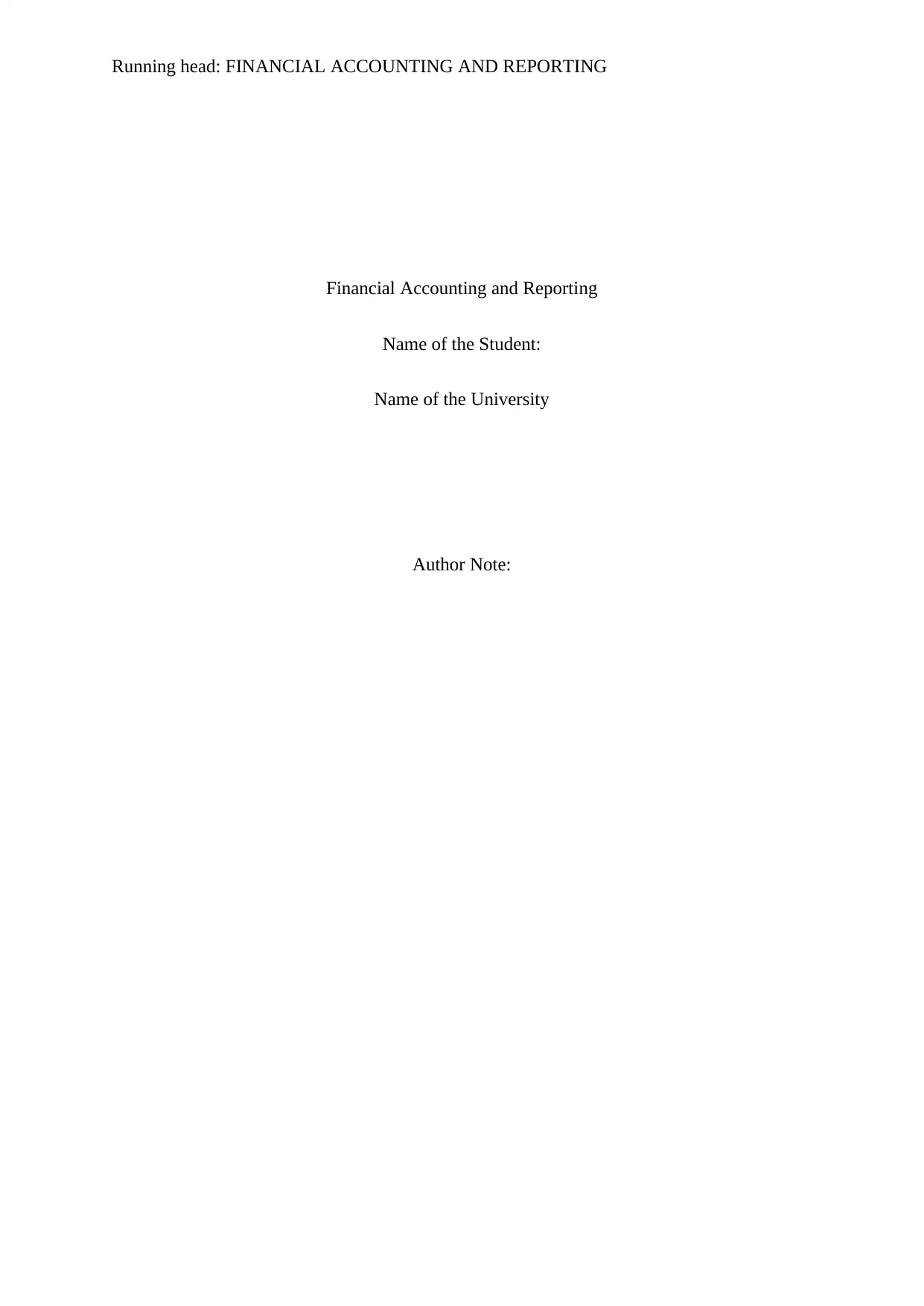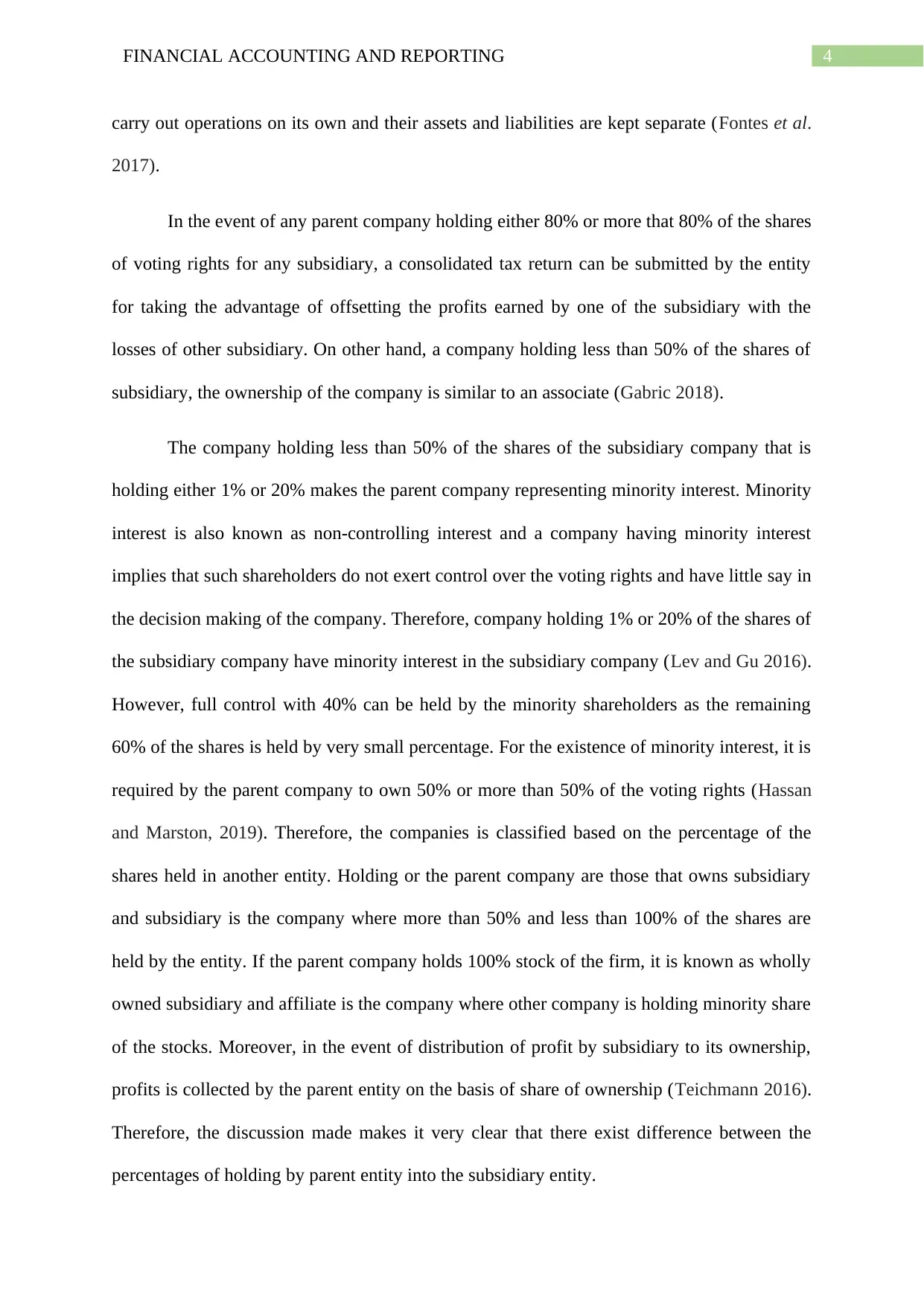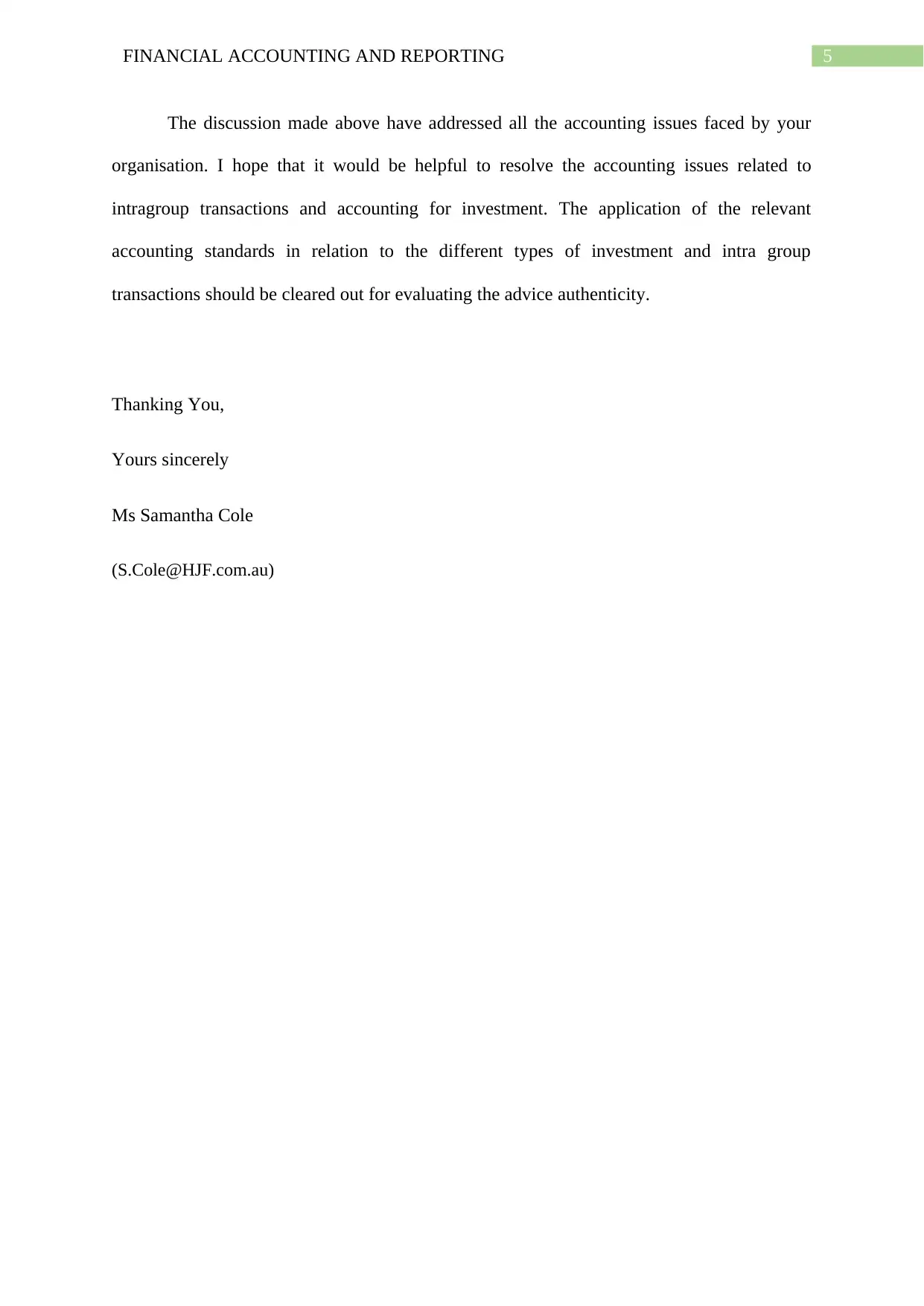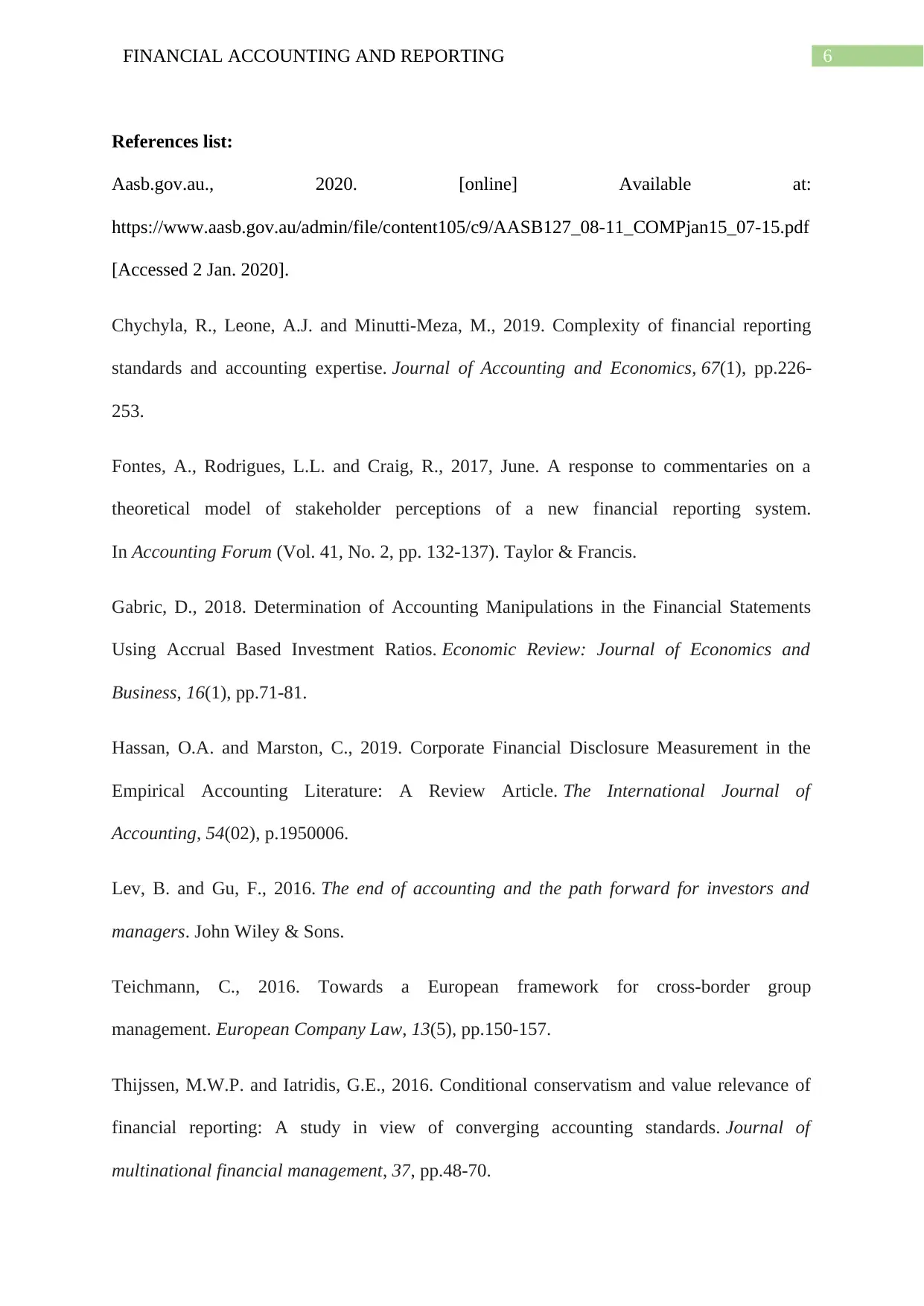ACCM4300: Financial Accounting & Reporting Assessment 3 Report
VerifiedAdded on 2022/09/06
|6
|1430
|20
Report
AI Summary
This report, prepared for the CEO of Tom Ltd by a graduate accountant at HJF Ltd, addresses critical accounting issues related to business combinations and consolidated financial statements. The report delves into the elimination of intra-group transactions, emphasizing the importance of removing unrealized profits and losses to accurately reflect the financial position of the group. It provides a clear example of how profit elimination works in the context of intercompany sales. Furthermore, the report clarifies the accounting treatment of different types of investments based on the percentage of ownership held by the parent company in a subsidiary, distinguishing between wholly owned subsidiaries, those with minority interests, and associates. The report also explains the implications of consolidated tax returns and the concept of non-controlling interest. The analysis is grounded in relevant accounting standards and provides a comprehensive understanding of the topics.

Running head: FINANCIAL ACCOUNTING AND REPORTING
Financial Accounting and Reporting
Name of the Student:
Name of the University
Author Note:
Financial Accounting and Reporting
Name of the Student:
Name of the University
Author Note:
Paraphrase This Document
Need a fresh take? Get an instant paraphrase of this document with our AI Paraphraser

2FINANCIAL ACCOUNTING AND REPORTING
From: Ms. Samantha Cole
Direct Manager
HJF Limited
40 Collins Street, Melbourne, VIC 3000.
To: King Edward (K.Edwards@Tom.com.au)
CEO of Tom Limited
Date: 2nd January, 2020
Subject: Accounting Issues: Business combination and consolidated financial statements
Respected Sir,
I have gone through your e mail explaining the accounting issues related to intra
group transactions and related to different types of investment. I am writing you to provide a
detailed analysis of the accounting issues you have presented and at the same time would like
to thank you for choosing us and providing the opportunity to assist the board of directors in
their decision making process. For your convenience, I would be addressing each of the
issues separately which is discussed below.
The first issue is related to the elimination of intra group transactions prior to
preparing the consolidated financial statement. The question is why such transactions are
recorded as it is required to omit and therefore, does not make any logic. In the consolidation
procedures, as per paragraph B 86 of AASB10 of the consolidated financial statement, it is
required to fully eliminate the intra liabilities and assets, cash flows, expenses and income
associated to the transactions between group entities. In addition to this, it is also required to
From: Ms. Samantha Cole
Direct Manager
HJF Limited
40 Collins Street, Melbourne, VIC 3000.
To: King Edward (K.Edwards@Tom.com.au)
CEO of Tom Limited
Date: 2nd January, 2020
Subject: Accounting Issues: Business combination and consolidated financial statements
Respected Sir,
I have gone through your e mail explaining the accounting issues related to intra
group transactions and related to different types of investment. I am writing you to provide a
detailed analysis of the accounting issues you have presented and at the same time would like
to thank you for choosing us and providing the opportunity to assist the board of directors in
their decision making process. For your convenience, I would be addressing each of the
issues separately which is discussed below.
The first issue is related to the elimination of intra group transactions prior to
preparing the consolidated financial statement. The question is why such transactions are
recorded as it is required to omit and therefore, does not make any logic. In the consolidation
procedures, as per paragraph B 86 of AASB10 of the consolidated financial statement, it is
required to fully eliminate the intra liabilities and assets, cash flows, expenses and income
associated to the transactions between group entities. In addition to this, it is also required to

3FINANCIAL ACCOUNTING AND REPORTING
completely eliminate the losses and profits resulting from any intragroup transactions. The
intragroup losses are required to be eliminated because such transaction might indicate
impairment and this is to be recognized in the consolidated financial statement (Aasb.gov.au
2020). The accounting treatment in relation to the intra group transaction as per the
accounting standard requires the intra group transactions to be absolutely eliminated. It is
important to eliminate the losses and profits arising from such transactions so that any
unrealized loss and profits are eliminated completely.
I will try to make the treatment of intra group transaction very clear to you with the
help of an example. When goods are sold by the group entity to another, then the profits
made on sales are recognized by the selling entity. From the viewpoint of selling company,
the profit recognized has not earned yet and would not be earned until the goods are sold
somewhere outside the group. Such unrealized profit on closing inventories is supposed to be
eliminated from the profit of the group in the event of consolidation. In addition to this, such
closing inventories should be recorded at cost. There is elimination of all the profits earned
on the transaction in the event of selling of the goods to a subsidiary by the parent entity.
Such treatment is done regardless of percentage of shares which the parent entity holds
(Chychyla et al. 2019). Therefore, it is required to completely eliminate the intra group
transactions in the preparation of consolidated financial statements.
The second issue is regarding the accounting of different types of investments where
you have asked to summarize the difference between different percentages held of another
entity. A parent entity of any subsidiary company may be one of several owners or the sole
owner. Any holding or parent company holding 100% of another entity implies that the
company owns 100% of the subsidiary. When the total amount of stocks held is less than
50%, it is required to have consolidated reporting by forming parent subsidiary relationship.
The parent company holding certain percentage of other entity that is known as subsidiary
completely eliminate the losses and profits resulting from any intragroup transactions. The
intragroup losses are required to be eliminated because such transaction might indicate
impairment and this is to be recognized in the consolidated financial statement (Aasb.gov.au
2020). The accounting treatment in relation to the intra group transaction as per the
accounting standard requires the intra group transactions to be absolutely eliminated. It is
important to eliminate the losses and profits arising from such transactions so that any
unrealized loss and profits are eliminated completely.
I will try to make the treatment of intra group transaction very clear to you with the
help of an example. When goods are sold by the group entity to another, then the profits
made on sales are recognized by the selling entity. From the viewpoint of selling company,
the profit recognized has not earned yet and would not be earned until the goods are sold
somewhere outside the group. Such unrealized profit on closing inventories is supposed to be
eliminated from the profit of the group in the event of consolidation. In addition to this, such
closing inventories should be recorded at cost. There is elimination of all the profits earned
on the transaction in the event of selling of the goods to a subsidiary by the parent entity.
Such treatment is done regardless of percentage of shares which the parent entity holds
(Chychyla et al. 2019). Therefore, it is required to completely eliminate the intra group
transactions in the preparation of consolidated financial statements.
The second issue is regarding the accounting of different types of investments where
you have asked to summarize the difference between different percentages held of another
entity. A parent entity of any subsidiary company may be one of several owners or the sole
owner. Any holding or parent company holding 100% of another entity implies that the
company owns 100% of the subsidiary. When the total amount of stocks held is less than
50%, it is required to have consolidated reporting by forming parent subsidiary relationship.
The parent company holding certain percentage of other entity that is known as subsidiary
⊘ This is a preview!⊘
Do you want full access?
Subscribe today to unlock all pages.

Trusted by 1+ million students worldwide

4FINANCIAL ACCOUNTING AND REPORTING
carry out operations on its own and their assets and liabilities are kept separate (Fontes et al.
2017).
In the event of any parent company holding either 80% or more that 80% of the shares
of voting rights for any subsidiary, a consolidated tax return can be submitted by the entity
for taking the advantage of offsetting the profits earned by one of the subsidiary with the
losses of other subsidiary. On other hand, a company holding less than 50% of the shares of
subsidiary, the ownership of the company is similar to an associate (Gabric 2018).
The company holding less than 50% of the shares of the subsidiary company that is
holding either 1% or 20% makes the parent company representing minority interest. Minority
interest is also known as non-controlling interest and a company having minority interest
implies that such shareholders do not exert control over the voting rights and have little say in
the decision making of the company. Therefore, company holding 1% or 20% of the shares of
the subsidiary company have minority interest in the subsidiary company (Lev and Gu 2016).
However, full control with 40% can be held by the minority shareholders as the remaining
60% of the shares is held by very small percentage. For the existence of minority interest, it is
required by the parent company to own 50% or more than 50% of the voting rights (Hassan
and Marston, 2019). Therefore, the companies is classified based on the percentage of the
shares held in another entity. Holding or the parent company are those that owns subsidiary
and subsidiary is the company where more than 50% and less than 100% of the shares are
held by the entity. If the parent company holds 100% stock of the firm, it is known as wholly
owned subsidiary and affiliate is the company where other company is holding minority share
of the stocks. Moreover, in the event of distribution of profit by subsidiary to its ownership,
profits is collected by the parent entity on the basis of share of ownership (Teichmann 2016).
Therefore, the discussion made makes it very clear that there exist difference between the
percentages of holding by parent entity into the subsidiary entity.
carry out operations on its own and their assets and liabilities are kept separate (Fontes et al.
2017).
In the event of any parent company holding either 80% or more that 80% of the shares
of voting rights for any subsidiary, a consolidated tax return can be submitted by the entity
for taking the advantage of offsetting the profits earned by one of the subsidiary with the
losses of other subsidiary. On other hand, a company holding less than 50% of the shares of
subsidiary, the ownership of the company is similar to an associate (Gabric 2018).
The company holding less than 50% of the shares of the subsidiary company that is
holding either 1% or 20% makes the parent company representing minority interest. Minority
interest is also known as non-controlling interest and a company having minority interest
implies that such shareholders do not exert control over the voting rights and have little say in
the decision making of the company. Therefore, company holding 1% or 20% of the shares of
the subsidiary company have minority interest in the subsidiary company (Lev and Gu 2016).
However, full control with 40% can be held by the minority shareholders as the remaining
60% of the shares is held by very small percentage. For the existence of minority interest, it is
required by the parent company to own 50% or more than 50% of the voting rights (Hassan
and Marston, 2019). Therefore, the companies is classified based on the percentage of the
shares held in another entity. Holding or the parent company are those that owns subsidiary
and subsidiary is the company where more than 50% and less than 100% of the shares are
held by the entity. If the parent company holds 100% stock of the firm, it is known as wholly
owned subsidiary and affiliate is the company where other company is holding minority share
of the stocks. Moreover, in the event of distribution of profit by subsidiary to its ownership,
profits is collected by the parent entity on the basis of share of ownership (Teichmann 2016).
Therefore, the discussion made makes it very clear that there exist difference between the
percentages of holding by parent entity into the subsidiary entity.
Paraphrase This Document
Need a fresh take? Get an instant paraphrase of this document with our AI Paraphraser

5FINANCIAL ACCOUNTING AND REPORTING
The discussion made above have addressed all the accounting issues faced by your
organisation. I hope that it would be helpful to resolve the accounting issues related to
intragroup transactions and accounting for investment. The application of the relevant
accounting standards in relation to the different types of investment and intra group
transactions should be cleared out for evaluating the advice authenticity.
Thanking You,
Yours sincerely
Ms Samantha Cole
(S.Cole@HJF.com.au)
The discussion made above have addressed all the accounting issues faced by your
organisation. I hope that it would be helpful to resolve the accounting issues related to
intragroup transactions and accounting for investment. The application of the relevant
accounting standards in relation to the different types of investment and intra group
transactions should be cleared out for evaluating the advice authenticity.
Thanking You,
Yours sincerely
Ms Samantha Cole
(S.Cole@HJF.com.au)

6FINANCIAL ACCOUNTING AND REPORTING
References list:
Aasb.gov.au., 2020. [online] Available at:
https://www.aasb.gov.au/admin/file/content105/c9/AASB127_08-11_COMPjan15_07-15.pdf
[Accessed 2 Jan. 2020].
Chychyla, R., Leone, A.J. and Minutti-Meza, M., 2019. Complexity of financial reporting
standards and accounting expertise. Journal of Accounting and Economics, 67(1), pp.226-
253.
Fontes, A., Rodrigues, L.L. and Craig, R., 2017, June. A response to commentaries on a
theoretical model of stakeholder perceptions of a new financial reporting system.
In Accounting Forum (Vol. 41, No. 2, pp. 132-137). Taylor & Francis.
Gabric, D., 2018. Determination of Accounting Manipulations in the Financial Statements
Using Accrual Based Investment Ratios. Economic Review: Journal of Economics and
Business, 16(1), pp.71-81.
Hassan, O.A. and Marston, C., 2019. Corporate Financial Disclosure Measurement in the
Empirical Accounting Literature: A Review Article. The International Journal of
Accounting, 54(02), p.1950006.
Lev, B. and Gu, F., 2016. The end of accounting and the path forward for investors and
managers. John Wiley & Sons.
Teichmann, C., 2016. Towards a European framework for cross-border group
management. European Company Law, 13(5), pp.150-157.
Thijssen, M.W.P. and Iatridis, G.E., 2016. Conditional conservatism and value relevance of
financial reporting: A study in view of converging accounting standards. Journal of
multinational financial management, 37, pp.48-70.
References list:
Aasb.gov.au., 2020. [online] Available at:
https://www.aasb.gov.au/admin/file/content105/c9/AASB127_08-11_COMPjan15_07-15.pdf
[Accessed 2 Jan. 2020].
Chychyla, R., Leone, A.J. and Minutti-Meza, M., 2019. Complexity of financial reporting
standards and accounting expertise. Journal of Accounting and Economics, 67(1), pp.226-
253.
Fontes, A., Rodrigues, L.L. and Craig, R., 2017, June. A response to commentaries on a
theoretical model of stakeholder perceptions of a new financial reporting system.
In Accounting Forum (Vol. 41, No. 2, pp. 132-137). Taylor & Francis.
Gabric, D., 2018. Determination of Accounting Manipulations in the Financial Statements
Using Accrual Based Investment Ratios. Economic Review: Journal of Economics and
Business, 16(1), pp.71-81.
Hassan, O.A. and Marston, C., 2019. Corporate Financial Disclosure Measurement in the
Empirical Accounting Literature: A Review Article. The International Journal of
Accounting, 54(02), p.1950006.
Lev, B. and Gu, F., 2016. The end of accounting and the path forward for investors and
managers. John Wiley & Sons.
Teichmann, C., 2016. Towards a European framework for cross-border group
management. European Company Law, 13(5), pp.150-157.
Thijssen, M.W.P. and Iatridis, G.E., 2016. Conditional conservatism and value relevance of
financial reporting: A study in view of converging accounting standards. Journal of
multinational financial management, 37, pp.48-70.
⊘ This is a preview!⊘
Do you want full access?
Subscribe today to unlock all pages.

Trusted by 1+ million students worldwide
1 out of 6
Related Documents
Your All-in-One AI-Powered Toolkit for Academic Success.
+13062052269
info@desklib.com
Available 24*7 on WhatsApp / Email
![[object Object]](/_next/static/media/star-bottom.7253800d.svg)
Unlock your academic potential
Copyright © 2020–2025 A2Z Services. All Rights Reserved. Developed and managed by ZUCOL.





